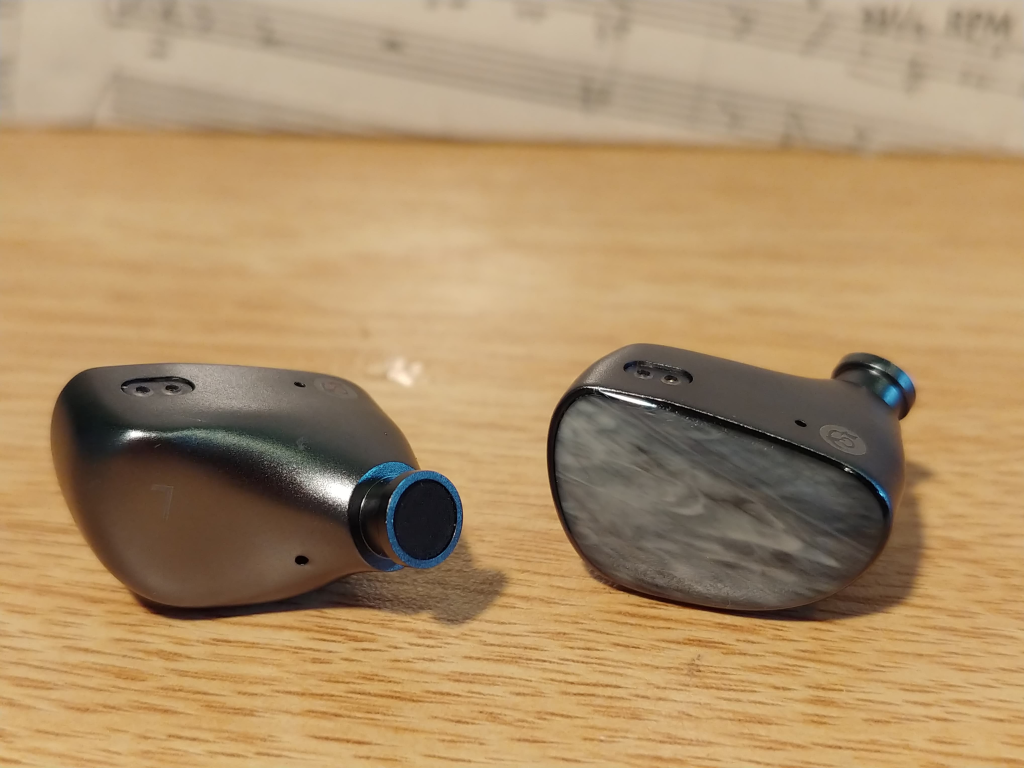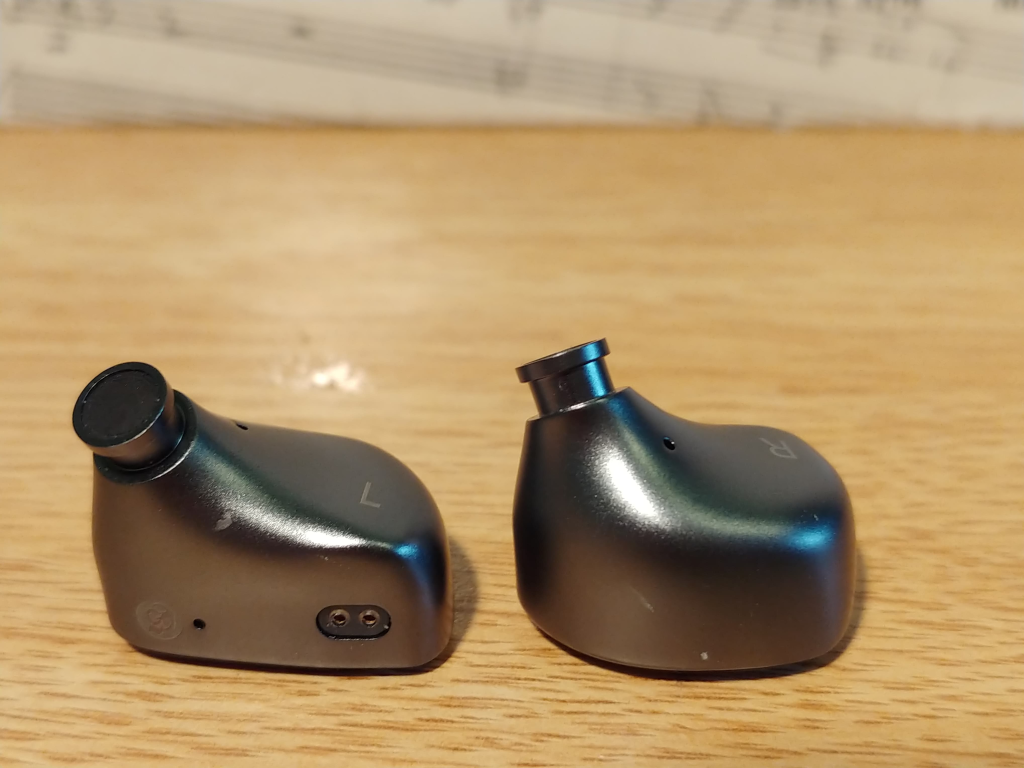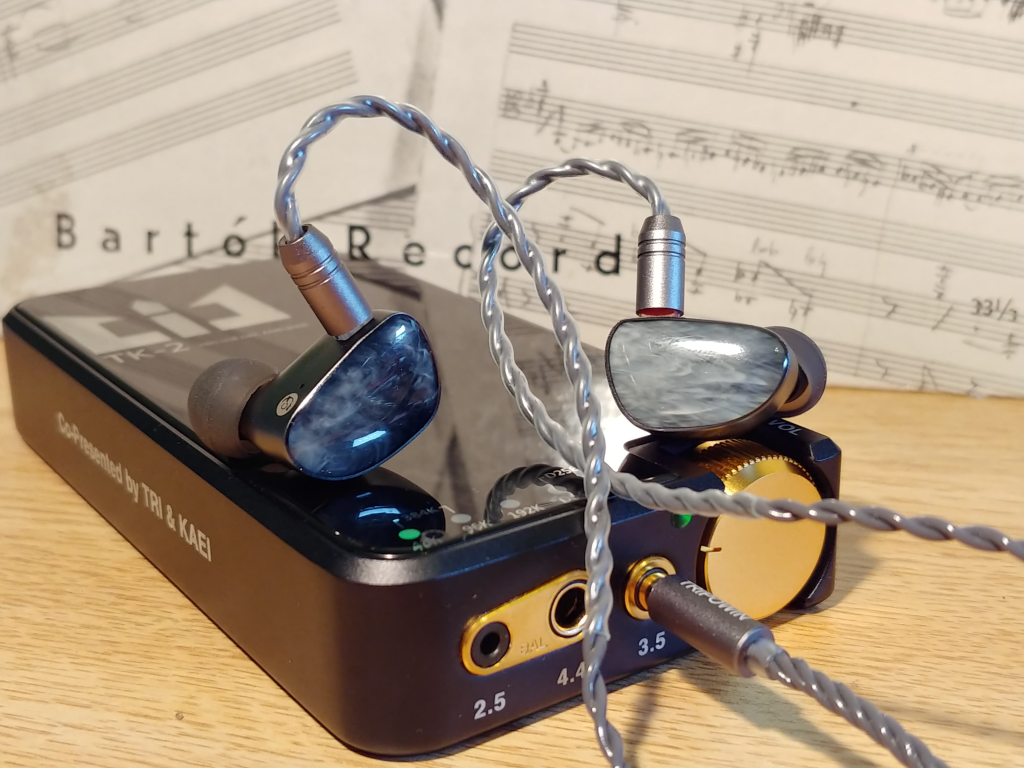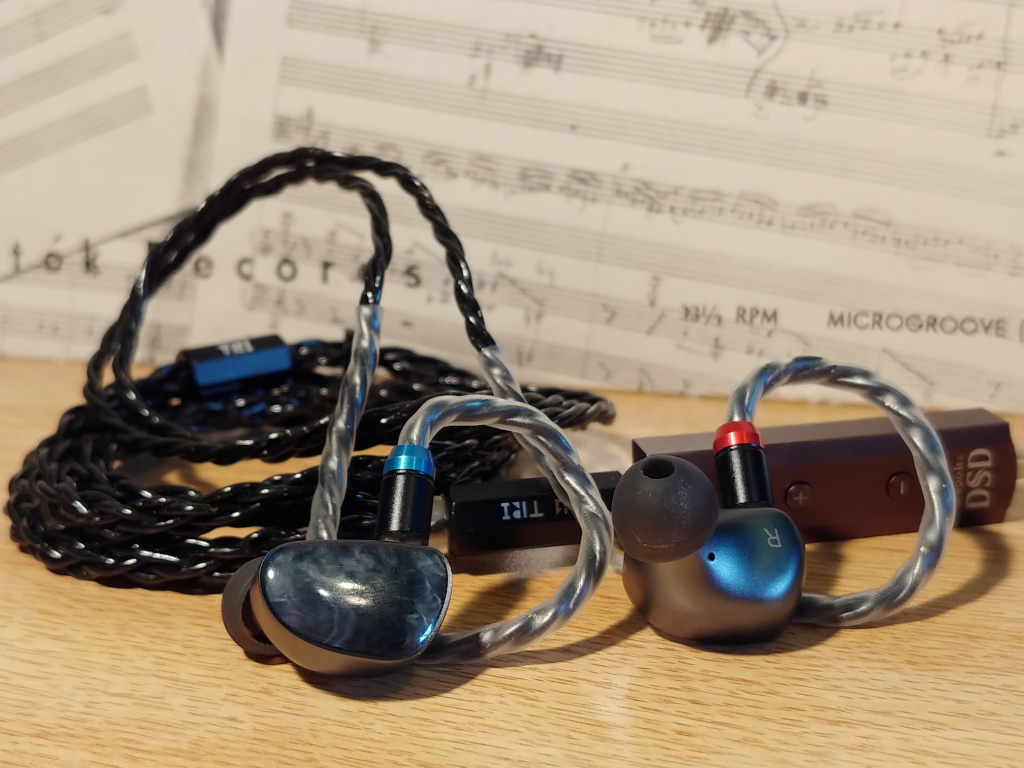
The PLUS:
-Great resolution
-Fast attack with good control
-realist timbre with good transparency
-sax and woodwinds sound excellent
-Good imaging-layering
-well balanced bright W shape signature
-good sound value
-legit hype
The MINUS:
-a bit distant in dynamic impact (light note weight)
-slightly dry timbre
-bass lack rumble and body
-slight timbral imbalance
-8khz peak that can create treble imbalance
TONALITY: 8/10
TECHNICALITIES: 8.8/10
CONSTRUCTION: 8.5/10
SOUND VALUE: 8.5/10
TRIPOWIN begin to get recognition with it’s numerous best seller IEM like TC-01, Mele and Lea which all get praise for their high sound benefit return. Their latest offering, the Tripowin Olina that I will review today, receive overwhelming praise. This is mostly due to a good marketing strategy that highlight the fact Olina use a similar Carbon nano tube dynamic driver than the legendary Tanchjim Oxygen. While it was confirm the DD have the same diaphragm, it doesn’t mean those 2 share similar tonality or as refined technicalities since acoustic design as a whole is of prime importance here. Let see in this ”post-hype” review if the Olina will really be an IEM that will pass test of time.
CONSTRUCTION


In term of packaging, it’s minimal yet enough. The carrying case is of good quality, the cable is basic but doesn’t affect negatively the sound and the 6 pairs of ear tips are appropriate to achieve a diversify sound experience. As well, it does include extra nozzle filters.



In term of design, this seem to be exact same one than Mele, which is good. It’s all aviation grade alluminium body with a beautifull decorative back plate which make all IEM unique in their look.
The shape is ergonomic without any sharp corner, the metal being smooth, the fit is easy and secure for long listening session.
SOUND IMPRESSIONS
(gear used: Ibasso DX90, Tri TK2, Xduoo Link2 BAL, Tempotec E44, Fiio KA1)

TONALITY
The Olina offer a softed bright W shape with slight mid bass and lower mid boost, and more important upper mids and mid treble boost. It doesnt sound overly bright even if the approach is near analytical in it’s details rendering. Attack peaks are a bit tamed to avoid important agressivity but still, this isn’t warm or dark IEM at all and treble is what is put fowards, which will be surely too much for some listener that are sensible to high frequencies. No wonder why you read everywhere about how to mod the Olina to tame it’s treble, but for this review all impressions are based on stock sound. To my ears, tonality is more technical than musical in it’s presentation.
While cable doesn’t really affect tonality, the ear tips choice are of prime importance here since wide bore will tend to make the Olina a bit more shouty while the one with long nozzle will improve imaging but make upper treble a bit sharper and bass a bit more distant.
TIMBRE is very realist with great transparency and generous amount of texture nuance, a hint dry-bright and thin, so it’s not lush nor warm at all, but it isn’t grainy, clinical or artificial too. I would have prefer a bit more density, since the timbre remind me the one of Lea.
BASS is fast and thumpy, but the punch doesn’t move lot of air and feel a bit scooped in impact. As well, this isn’t a low end i would call fulld bodied since the slam is dry and rumble lack presence and vibrant density. Extension is a bit roll off and will favorise kick drum more than bass line. Still, electric bass like slap bass sound very good because the texture is well done, this isn’t warm bass, definition and presence is well resolve. Toms will cut short in natural resonance and cello will lack a bit of body and sometime this will affect it’s tone negatively. Their just a sligth bass to lower mids embrace here, this affect mostly the definition edge of kick drum, which have it’s presence preserved with texture.
MIDS are gently bright with a focus on texture and well rounded but elevated upper mids, it’s energic and clear with high level of sound info. Both male and female vocal are fowards and wide in presence, while not recessed, female vocal is a bit thin and a hint lipsy. For male vocal, body is fuller but still a bit dry and overly textured. When it come to saxophone or woodwind magic happen and the restitution is mavervellously full, dense in air, natural in timbre yet rich in texture and wide and airy in it’s layering. I don’t know what explain this result, but I can’t get enough sax music with the Olina since it sound too good. Now, for the piano, result is more mixed, the note weight isn’t there nor the natural decay, so this make piano a bit recessed and not lively, though it’s detailed and well articulated whatever the speed of playing. Another instrument that sound great with the Olina is electric guitar, and to some extend violin too, but let’s talk about these in treble section.
TREBLE is all about texture and micro details, yet it seem aware of dangerous peak that can create sibilance, while a bit less aware of those that create shoutyness which is very minimal and only can occur with excited percussion like crash cymbals. Olina dig reveal alot of micro details, to the point it can be unpermissive of bad recording since it tend to show the background hiss of them or their distortion. I have none of this issue with let say Anouar Brahem ”The astouding eyes of Rita” in 96khz/24bit hi res flac, and it proove Olina doesn’t add any grain or hiss but just restitute the music in high fidelity. This album is good to judge treble sparkle, brilliance and decay, let say Olina is more about snap and brilliance than appealing sparkle since decay cut short, but acoustic guitar or Brahem tunisian Oud are greatly detailed in texture, which make string pulling details very fascinating, we can hear how it vibrate, the articulation of every strings being magnify in lead attack. Still, I will not call the highs very airy. Sound info are rather condensed, even if never muddy due to great transparency, crisp resolution and fast snappy attack.
TECHNICALITIES
Olina are sure no slouch when it come to technical performance, the CNT DD showing it’s muscle in level of resolution we get as well as very impressive attack speed that permit this IEM to deal with fast busy track with ease. Their not a single track that can overwhelm Olina transient response, my go to album for testing complex speed is ”Dodovoodoo” by Elephant9 and it was a pure bliss in term of accurate resolution that never go muddy or distorted, every layer of instrument playing at crazy speed in their own space. So, while the speed is impressive, the dynamic rendering can feel a bit compressed in amplitude as if all instrument play in same sound pressure level which isn’t always the case, as well, i would not call the presentation as holographic due to a lack of relief in definition. When it come to bass and treble extension, i feel it doesn’t fully extend in both end. Sustain-decay balance isn’t the best too, since it’s a hint shouty in articulation and lack both weight lead and post-attack natural decay, it focus on a rough snap.
IMAGING is very good, thanks to high resolution and treble bite, but it’s a bit compressed in center, with a very dense amount of transparent sound layer, so for me it’s difficult sometime to pin point exact position of instrument in this region, but stereo separation is great.
SOUNDSTAGE is quite wide, not very tall and minimally deep, it have a triangle shape where the stereo rendering is wide and central one is closed.
COMPARISONS

VS HZSOUND HEART MIRROR (1DD-50$)
Yep, these always come back when it’s about technical prowess and again, I will surprise some people here since it’s evident to me HZ is technically superior to the great Olina. But did it mean tonality is more appealing? That’s your story here not mine.
HZ is more W shape and energic, with crisper, airier and cleaner tonality. The bass is fuller, better separated, weightier in punch and extend fully while it’s more about slight mid bass boom with the Olina. Mids are more fowards and better extracted, cleaner, with better clarity and imaging, notably better transparency too, but perhaps less wide and open vocal presentation, so it can feel a bit centered and less immersive than Olina here. Male vocal (lower mids) of Olina have more presence too, so it sound fuller and better musicaly. Treble is less grainy and bright, more liquid yet more snappy and sparkly and full in restitution. Timbre here is very different, Olina is brighter and a bit more grainy while HZ can sometime lack a bit of texture nuance due to it being well polished, this translate to in being just a hint thinner than Olina, though notably more transparent. Soundstage is another big difference, Olina sound more wide and tall but we can’t travel as deep in sound spatiality, still presentation is more holographic and enjoyable here. Imaging is near equal, but as said, cleaner resolution of HZ tend to make it more accurate and sharper in separation. To some extend, we can say tonality of Olina is more musical and immersive while HZ force you to be a critical listener. Bass performance is certainly superior with HZ, yet dynamic weight isn’t magnify. Olina is less capricious about source even if i need to crank up Tri TK2 more….but was is because HZ is more agressive in SPL?
All in all, I love both but again, their not a single doubt HZ offer snappier, faster, clearer, cleaner, sharper and more refined technical performance.
VS MOONDROP ARIA
First thing that hit is how smoother and more organic and open sound the Aria. Yes, Olina is brighter and more analytical in it’s treble, which focus more on texture than sparkle and airy extension. Bass presentation too is very different, Aria have more sub bass presence and the slam is weightier and more rounded yet warmer in resolution and slower-softer in impact. For rock Olina will sound better due to its fast punchy textured bass, while for jazz acoustic bass line will extend lower in a more natural way with Aria. Mids are better for male vocal with Olina, it’s less recessed and more bodied with better presence extraction and more texture. For higher pitch instrument or female vocal, Olina is again brighter and this time leaner and more recessed than Aria even if their more upper mids energy, which translate in higher risk of sibilance with Olina, Agnes Obel sound more upfront and wider in presence yet smoother and more transparent in vocal presentation, all in all, mid range tonality is more natural with Aria though not as well define in definition edge and more polished in texture. Treble is more crunchy and texture focus with Olina, this give instrument more immediacy and bite in attack, but sparkle decay and brilliance is less present than Aria. Their more 8khz and overall mid treble boost with Olina, so it will extract background hiss more and inflict on clean presentation, in that regard, Aria take the opposite road and tame texture and micro-details amount of this section which result in a more relaxed, laid back and clean tonality and extra air dip that make treble seem more extended, which might be an illusion in fact. Simply put, Aria is safely tuned, hint better balanced and cohesive as a whole, but not as fast in attac and rich in details. Micro-definition and overall resolution is higher with Olina as well as dynamic energy is more fowards and excited.
It’s hard to choose a clear winner here since I love both and tonality is too different to not feel they complement well each other.
VS MOONDROP KATO:
Now, we are into similar tonal territories, both being brightish ”harman target” take, what hit first here it’s how the dynamic range is presented, Kato having a more thumpy and balanced bass presentation as well as fuller thicker timbre and more notes weights in attack. In term of resolution, the 2 are on par, Olina perhaps have upper hands in transparency and micro details since it’s treble is more boosted in mid highs. Bass is where I can confidently say that both quality and quantity is superior with Kato, bass line are more flexible in articulation, resonance is less muffled and texture is better balanced in timbral balance, sens of impact is weightier and better define and separated, while Olina lack this important physicality of slam and thump. Mids are very similar in lower region, delivering great male vocal presence, for female vocal the Olina extract their presence better and make them wide open and more transparent yet beautifully textured but thinner timbre and less full body and more emphasis in higher harmonic. Simply put, the mids of Kato are a bit more agressive but fuller and more natural. Treble is where big different occur, the Olina is less well balanced in that regard and tend to put fowards some grain and texture, it dig greater amount of micro details in a lean way with extra 8khz spice that doesn’t always feel in it’s place.
Wow, this comparison is very difficult since those 2 sound very similar on tonality and both have great technicalities, it’s more about how the dynamic is presented, here Olina being leaner and more compressed than Kato, but far from muddy or incompetent. So, let’s just say the Kato is a sligthly more refined Olina with fuller tonality and more cohesive balance as well as more lead attack weight and impact. This make the Olina sound more bright-neutral and bass light. Taking the fact Kato sell for near 2 times the price, Olina represent a better sound value.
CONCLUSION

While my expectation might have been too high for the Olina, it sure doesn’t disappoint me in term of technical performance which are excellent in term of attack speed, accuracy and resolution. Yes, the hype is legitimate for sure, though the bright bass light tonality will not appeal everyone.
If you search for a well balanced W shape signature that offer crisp resolution and will deal like a champion even with your fastest jazz rock or metal track, the Tripowin Olina might be among cheapest introduction to high fidelity audiophile sound. Just don’t expect it to be lush, warm or super bassy and be sure to give them the best music quality and audio source since like all high fidelity IEM, the Olina will scale up with clean audio free of grain, hiss or distortion.
Highly recommended!
——
PS:I wanna thanks Linsoul for providing me this review sample. I’m not affiliated to this audio distributor and have not been pay by them. As always, this is my 100% subjective truth.
You can buy the Tripowin Olina exclusively in Linsoul store for 99$ HERE
Or in their Aliexpress store here (on sale right now for 90$) HERE
Or their Amazon store here (95$) HERE


olina not good enough to be added in your page https://nobsaudiophile.com/best-iem/ ? or did you just stop updating this (usefull) page ?
Olina sure worth it’s place there, i just didnt update it, now it’s done. Let say I try to update this list every month.